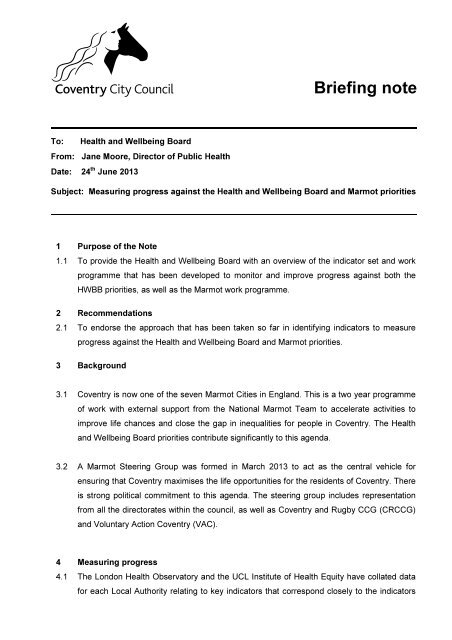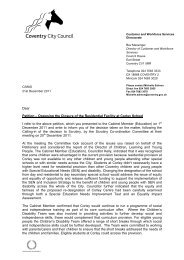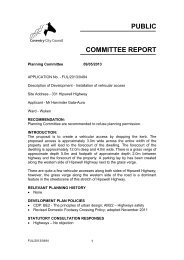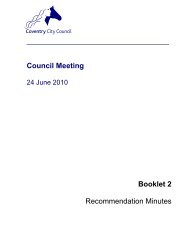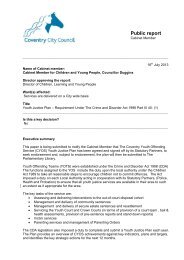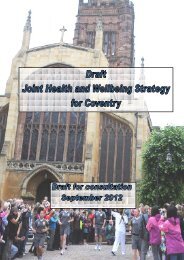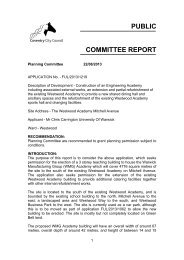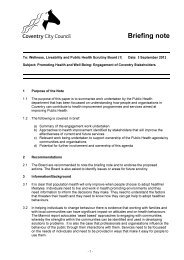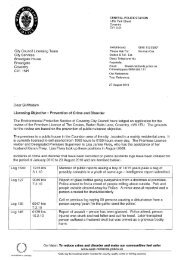Briefing note - Meetings, agendas, and minutes - Coventry City ...
Briefing note - Meetings, agendas, and minutes - Coventry City ...
Briefing note - Meetings, agendas, and minutes - Coventry City ...
Create successful ePaper yourself
Turn your PDF publications into a flip-book with our unique Google optimized e-Paper software.
abc<br />
<strong>Briefing</strong> <strong>note</strong><br />
To: Health <strong>and</strong> Wellbeing Board<br />
From: Jane Moore, Director of Public Health<br />
Date: 24 th June 2013<br />
Subject: Measuring progress against the Health <strong>and</strong> Wellbeing Board <strong>and</strong> Marmot priorities<br />
1 Purpose of the Note<br />
1.1 To provide the Health <strong>and</strong> Wellbeing Board with an overview of the indicator set <strong>and</strong> work<br />
programme that has been developed to monitor <strong>and</strong> improve progress against both the<br />
HWBB priorities, as well as the Marmot work programme.<br />
2 Recommendations<br />
2.1 To endorse the approach that has been taken so far in identifying indicators to measure<br />
progress against the Health <strong>and</strong> Wellbeing Board <strong>and</strong> Marmot priorities.<br />
3 Background<br />
3.1 <strong>Coventry</strong> is now one of the seven Marmot Cities in Engl<strong>and</strong>. This is a two year programme<br />
of work with external support from the National Marmot Team to accelerate activities to<br />
improve life chances <strong>and</strong> close the gap in inequalities for people in <strong>Coventry</strong>. The Health<br />
<strong>and</strong> Wellbeing Board priorities contribute significantly to this agenda.<br />
3.2 A Marmot Steering Group was formed in March 2013 to act as the central vehicle for<br />
ensuring that <strong>Coventry</strong> maximises the life opportunities for the residents of <strong>Coventry</strong>. There<br />
is strong political commitment to this agenda. The steering group includes representation<br />
from all the directorates within the council, as well as <strong>Coventry</strong> <strong>and</strong> Rugby CCG (CRCCG)<br />
<strong>and</strong> Voluntary Action <strong>Coventry</strong> (VAC).<br />
4 Measuring progress<br />
4.1 The London Health Observatory <strong>and</strong> the UCL Institute of Health Equity have collated data<br />
for each Local Authority relating to key indicators that correspond closely to the indicators
proposed in Fair Society, Healthy Lives. A copy of these indicators <strong>and</strong> <strong>Coventry</strong>’s<br />
performance can be found in Appendix B. Whilst these indicators will prove helpful in<br />
measuring the shift required in health outcomes in <strong>Coventry</strong>, further work was needed to<br />
develop an indicator set that would measure the short term progress made in the city.<br />
4.2 An accelerated pace of change is required in <strong>Coventry</strong> to achieve the overall Marmot<br />
objective of reducing inequalities by 2015. The Marmot Steering Group has been working<br />
to collate a range of indicators to monitor inequalities in <strong>Coventry</strong>. A similar exercise has<br />
also been undertaken to develop a Health <strong>and</strong> Wellbeing Board indicator set that will<br />
measure progress against the priorities within the strategy. As there is considerable overlap<br />
between the indicators, the two indicator sets have been amalgamated to produce one<br />
inequality indicator set. Appendix A provides an overview of this combined indicator set.<br />
4.3 The Marmot work programme is based around the concept of ensuring that what we do<br />
impacts those most in need. The ideal indicator or way of measuring this would measure<br />
the difference between the best <strong>and</strong> the worst ‘performing’, <strong>and</strong> we could monitor how<br />
successful our efforts were at closing the ‘gap’. Unfortunately finding an indicator that<br />
measures this ‘gap’ can be difficult.<br />
4.4 When we measure anything, we need a big enough ‘sample’ or numbers involved to make<br />
sure that any changes are a result of what we are doing, rather than simply due to<br />
chance. When we try <strong>and</strong> measure the ‘gap’ the sample size we have is necessarily made<br />
smaller as we have to divide it into groups. This means that when we try <strong>and</strong> measure<br />
this, what we see could be caused by chance. For example; when we try <strong>and</strong> measure<br />
numbers smoking in the city as a whole, we can be reasonably confident that the changes<br />
are actually happening. If we tried to analyse this sample to see if we had seen a change<br />
in smokers in the most socioeconomically deprived groups we would have to divide the<br />
numbers into groups. As a result of this, the numbers are much lower <strong>and</strong> any change is<br />
more likely to be down to chance. Therefore, it isn’t fair to judge our efforts against this<br />
measure.<br />
4.5 Therefore, some of the indicators within the set are not necessarily measuring the ‘slope’ or<br />
gap. This doesn’t mean they are not useful locally though. For example, we already know<br />
that there are links between unemployment or obesity <strong>and</strong> socioeconomic deprivation. By<br />
ensuring the work programs that accompany the indicators are targeted primarily at the<br />
most disadvantaged in society, seeing wholesale reductions in these measures we should<br />
be seeing some improvements for those that really need it.<br />
2
5 Programme of Work<br />
During the development of the Marmot indicators, directorates across the <strong>City</strong> Council have been<br />
reviewing their contributions to improve life chances for the people of <strong>Coventry</strong>. The indicators<br />
have all been assigned a lead organisation or directorate. Key areas of work <strong>and</strong> ownership of<br />
indicators across the Council <strong>and</strong> CRCCG are outlined below.<br />
6 <strong>Coventry</strong> <strong>City</strong> Council: <strong>City</strong> Services <strong>and</strong> Development Directorate (CSDD)<br />
CSDD have identified the major opportunities for maximising the Marmot agenda as:<br />
• Ensuring the Job Shop is utilised as much as possible in <strong>Coventry</strong>. The Job Shop<br />
provides a range of support to unemployed <strong>and</strong> under-employed people in <strong>Coventry</strong>.<br />
• Increase access into Occupational Health for Job Shop customers <strong>and</strong> workless families<br />
with complex social problems.<br />
• Barrier Breaking Service - support to all Employment Team customers which can include<br />
specialist training, childcare, debt advice, referral to health support, confidence building<br />
<strong>and</strong> the direct purchase of other support that enables disadvantaged people to obtain<br />
<strong>and</strong> sustain work.<br />
• To deliver <strong>and</strong> create the <strong>Coventry</strong> Apprenticeship <strong>and</strong> Skills Hub for young people aged<br />
18-24 years- Youth Zone.<br />
• To provide intensive support for workless households <strong>and</strong> families with complex social<br />
barriers to work, enabling positive lifestyle changes <strong>and</strong> the development of skills for<br />
work.<br />
• To implement the <strong>Coventry</strong> Sport Strategy in 2013.<br />
• Promote <strong>and</strong> help businesses to attain recognised high st<strong>and</strong>ards in their approach to<br />
employee’s health <strong>and</strong> wellbeing via the Workplace Well Being Charter.<br />
• Reduce the number of homes where people cannot afford sufficient heating. Provide<br />
advice <strong>and</strong> practical solutions to reduce levels of fuel poverty in the city.<br />
• Create a coherent <strong>and</strong> safe cycle network that will link together the main residential<br />
areas, employment areas, local centres, railway stations <strong>and</strong> the city centre as part of the<br />
Cycle <strong>Coventry</strong> Project.<br />
• CSDD senior management team will take part in various initiatives during ‘Men’s Health<br />
Week’.<br />
CSDD will monitor progress against:<br />
Indicator<br />
Target<br />
3
Intensive support for workless families back into work<br />
441 referrals, 41 people into<br />
sustained employment <strong>and</strong> 10<br />
young people into positive<br />
destinations.<br />
Number of people assisted via the Job Shop 2500<br />
Number people supported into work via the job shop. 1000<br />
Number of young people into positive destinations<br />
including jobs, placements, apprenticeships etc. 250<br />
Employment support to people with severe <strong>and</strong><br />
enduring mental ill-health <strong>and</strong> autism.<br />
Investment into the city by March 2014.<br />
£60 million<br />
Number of jobs created in the city by March 2014 1250<br />
7 <strong>Coventry</strong> <strong>City</strong> Council: Finance <strong>and</strong> Legal Services<br />
Key areas of focus for Finance <strong>and</strong> Legal Services (FLS) will be:<br />
60 engaged, 15 into employment<br />
<strong>and</strong> 8 into positive destinations<br />
• To approve <strong>and</strong> launch the Business Charter <strong>and</strong> receive annual reports from businesses<br />
relating to social responsibility deliverables. This will support raising awareness of<br />
inequalities amongst businesses.<br />
• To incorporate the key Marmot principles into the Councils approach to Public Services<br />
(Social Value) Act 2013. This will support raising awareness of inequalities across Council<br />
employees.<br />
• To develop targeted communication to people in receipt of benefits.<br />
FLS will monitor progress against:<br />
Indicator<br />
Business's signed up to the business charter <strong>and</strong> providing an<br />
annual report on social responsibility deliverables.<br />
Incorporation of Marmot principles into the supply chain.<br />
Target<br />
To be determined<br />
To be determined<br />
8 <strong>Coventry</strong> <strong>City</strong> Council: Chief Executives Directorate<br />
8.1 Public Health Department<br />
The Public Health Department have committed to delivering against a number of initiatives<br />
intended to focus on reducing inequalities in <strong>Coventry</strong>.<br />
• Enabling <strong>Coventry</strong> <strong>City</strong> Council to consider the impact on health, to ensure that any<br />
decision that is taken maximises health gain to reduce inequalities. This will be achieved<br />
by developing <strong>and</strong> implementing a health impact assessment tool across the council.<br />
4
• Tackling physical activity <strong>and</strong> sedentary behaviour, utilising local leadership to encourage<br />
people to be more active.<br />
• Producing a model to support community asset based working in <strong>Coventry</strong>.<br />
• Stop smoking initiatives <strong>and</strong> migrant health needs assessment.<br />
• Developing a more effective JSNA process; which will exp<strong>and</strong> to include the wider<br />
determinants of health <strong>and</strong> greater use of multiple data sources, mapping <strong>and</strong><br />
consultation processes.<br />
• Establishing the impact of the economic downturn of health inequalities in <strong>Coventry</strong> <strong>and</strong><br />
mitigate the effects cost neutrally.<br />
Public health will monitor progress <strong>and</strong> work to improve performance against the following:<br />
Indicator<br />
Assessment of well being via the Warwick-Edinburgh Mental<br />
Well-being Scale (WEMWBS) from the <strong>Coventry</strong> Household<br />
Survey.<br />
Percentage of children aged 4-5 classified as overweight or<br />
obese.<br />
Household Survey data - smoking prevalence in the over<br />
16s.<br />
People presenting with HIV at a late stage of infection 2) Re<br />
- Audit of number of HIV tests done in general practice<br />
across <strong>Coventry</strong><br />
Breastfeeding rates at 6-8 weeks<br />
Making Every Contact Count- Numbers trained at UHCW<br />
<strong>and</strong> CWPT.<br />
Levels of physical activity (measured via the <strong>Coventry</strong><br />
Household Survey)<br />
Levels of physical activity (Active People Survey, Sport<br />
Engl<strong>and</strong>)<br />
Number of women that successfully quit smoking for 4<br />
weeks during pregnancy.<br />
Number of Health Impact Assessments performed during<br />
the pilot phase<br />
Number of school playgrounds <strong>and</strong> gates with smoke-free<br />
signage up<br />
Target<br />
No target can be set due to<br />
the yearly variation.<br />
To reduce obesity levels to<br />
9.2%.<br />
22.6% by 2014<br />
Target is to see a yearly<br />
increase in the number of HIV<br />
tests done in General Practice<br />
across <strong>Coventry</strong>.<br />
To increase breastfeeding<br />
rates by 2% each year.<br />
2013/14- 800 to be trained at<br />
UHCW, 1300 trained at<br />
CWPT<br />
Suggested increase of 1% per<br />
annum (to be agreed).<br />
Suggested increase of 1% per<br />
annum (to be agreed).<br />
140 women annually (35 per<br />
quarter).<br />
To be determined<br />
April 2014- 70% of schools<br />
with signage.<br />
8.2 <strong>Coventry</strong> <strong>City</strong> Council: Communications Department<br />
• The Communication department will provide continued support to all directorates once<br />
plans are confirmed.<br />
5
• Coordination of the Godiva Festival which will take place on 6 th /7 th July. <strong>Coventry</strong> <strong>City</strong><br />
Council Staff will be trained to deliver brief interventions <strong>and</strong> advice to families in relation<br />
to health.<br />
• Godiva Comes Home will take place on 10 th August. The ring road will be closed off <strong>and</strong><br />
people will be encouraged to utilise the space, making links with the physical activity <strong>and</strong><br />
sedentary behaviour work programme.<br />
Indicator<br />
% of families engaged with at Godiva<br />
Target<br />
Direct engagement with 50% of visitors to family<br />
field at Godiva Festival on health/activity issues.<br />
9 <strong>Coventry</strong> <strong>City</strong> Council: Customer <strong>and</strong> Workforce Services<br />
• Increase recruitment to the <strong>City</strong> Council from areas in <strong>Coventry</strong> with high unemployment<br />
rates.<br />
• Use the Occupational Health Services to deliver evidence-based health checks on men<br />
aged 40 <strong>and</strong> over working in <strong>City</strong> Services, with referral to NHS services as needed.<br />
• To utilise the contact centre in delivering key public health messages.<br />
Indicator<br />
Number of male employees aged
Key Stage 2 attainment Target will be developed in November 2013<br />
Narrowing the gap between the lowest Target will be developed in November 2013<br />
achieving 20% in Foundation Stage profile <strong>and</strong><br />
the rest<br />
Inspection/review visit judgements All good/outst<strong>and</strong>ing by September 2015<br />
Take up rates of 2 year old nursery places 2100 children in places by September 2014<br />
11 <strong>Coventry</strong> <strong>City</strong> Council: Community Services Directorate<br />
Key areas of focus for Community Services align both the Marmot agenda <strong>and</strong> the “A Bolder<br />
Community Services Programme” (ABCS) programme which has five key principles underpinning<br />
it:<br />
• To protect our most vulnerable residents<br />
• Using resources effectively<br />
o With much reduced resources we will need to make choices between what we are<br />
required to do <strong>and</strong> what we would like to do. This will mean stopping some areas<br />
of activity.<br />
• Working with residents, communities <strong>and</strong> partners to get things done<br />
o We will expect people to use more of the resources available to them i.e. families,<br />
friends <strong>and</strong> communities <strong>and</strong> be less reliant on the <strong>City</strong> Council<br />
o <strong>City</strong> Council support to be as last resort.<br />
• Being honest, fair <strong>and</strong> transparent when we make decisions<br />
• Reviewing <strong>and</strong> improving services<br />
Using these overarching principles whilst focusing our support on reducing health <strong>and</strong> social<br />
inequalities, it is intended that the proposed Marmot indicators be monitored over a period of 2<br />
years to enable a judgement to be made as to the adequacy <strong>and</strong> effectiveness of our approach,<br />
whilst recognising influences external to the directorate (e.g. the Comprehensive Spending<br />
Review, Recession or Benefit Reforms).<br />
Over the coming 3 years, Community Services has a comprehensive programme of reviewing<br />
every aspect of commissioning, provision <strong>and</strong> capacity. This programme is driven by the need to<br />
meet growing dem<strong>and</strong> in terms of complexity, demographics, <strong>and</strong> average length of episode,<br />
whilst facing a significant real terms reduction in available resources. The programme has been<br />
considered <strong>and</strong> supported through the political process, <strong>and</strong> agreed as part of the Council’s<br />
Medium Term Financial Plan up to <strong>and</strong> including 2015/16<br />
7
There is a range of detailed work going on across the directorate, including the recommissioning<br />
of a range of aspects of social care <strong>and</strong> housing related support, the introduction of the Making<br />
Every Contact Count (MECC) methodology to the directorate, the re-commissioning of domestic<br />
violence <strong>and</strong> abuse services, rolling out “Care 4 Your Area”, the delivery of the Troubled Families<br />
Programme, <strong>and</strong> a review of neighbourhood working <strong>and</strong> developing proposals which promote<br />
the asset based approach across the whole city. Specific areas of focus include:<br />
• MECC training to public facing staff across the directorate<br />
• Improving the city’s <strong>and</strong> the council’s underst<strong>and</strong>ing <strong>and</strong> support for people affected by<br />
welfare reform<br />
• Public safety promoting <strong>and</strong> piloting an asset based approach to their work<br />
• Improving the housing offer for vulnerable adults <strong>and</strong> older people<br />
Community services will monitor progress against the following indicators.<br />
Indicator<br />
% of DV incidents (DV & Crime) involving<br />
children<br />
Referrals to Sexual Assault Referral Centre<br />
Active use of books on prescription service<br />
The number of participants reporting<br />
physiological improvements upon completion of a<br />
10 week One Body One Life programme.<br />
% of women totally or partially breastfeeding at<br />
6/8 weeks after delivery following intervention by<br />
the infant feeding team<br />
Involuntary Homelessness<br />
People with a learning disability having a health<br />
check<br />
To reduce levels of DV (Crime <strong>and</strong> noncrime.<br />
In 2012/13 the level was 62.6%,<br />
As this constitutes a new indicator,<br />
target to be developed by October 2013<br />
As this constitutes a new service, a<br />
multi-agency target will be developed by<br />
October 2013<br />
To increase participation year on year<br />
by 5%<br />
To increase levels of improvements to<br />
75%<br />
To increase breastfeeding levels by 6%<br />
PA for 2 years<br />
To further reduce levels of involuntary<br />
homelessness, maintaining last year’s<br />
levels by a further 6% PA<br />
To increase health check levels by 10%<br />
over 2 year period.<br />
12 <strong>Coventry</strong> <strong>and</strong> Rugby Clinical Commissioning Group (CRCCG)<br />
The CCG have identified 3 priority areas for 2013/14; cervical screening, smoking cessation in<br />
pregnancy <strong>and</strong> alcohol related hospital admissions. The targets below relate to activity across<br />
both <strong>Coventry</strong> <strong>and</strong> Rugby.<br />
8
Smoking In Pregnancy - Smoking at time of<br />
delivery (SATOD) data is collected by the<br />
acute trust <strong>and</strong> also by community midwives<br />
in Rugby <strong>and</strong> <strong>Coventry</strong>.<br />
Hospital admissions wholly attributable to<br />
alcohol (including alcoholic liver disease).<br />
Smoking In Pregnancy - Smoking at time of<br />
delivery (SATOD) data is collected by the<br />
acute trust <strong>and</strong> also by community midwives<br />
in Rugby <strong>and</strong> <strong>Coventry</strong>.<br />
13.4% (<strong>Coventry</strong> <strong>and</strong> Rugby target)-<br />
Reduction in the number of women smoking<br />
at time of delivery<br />
To halt the rise on the number of hospital<br />
admissions wholly attributable to alcohol<br />
(including alcoholic liver disease). Target for<br />
13/14 same as forecast for 12/13 at 3100<br />
admissions.<br />
13.4% (<strong>Coventry</strong> <strong>and</strong> Rugby target)-<br />
Reduction in the number of women smoking<br />
at time of delivery<br />
• In relation to cervical screening, the CCG will be identifying poor performers, developing a<br />
local performance dashboard <strong>and</strong> reviewing ways to engage to improve performance.<br />
• To halt the rise of alcohol related admissions in <strong>Coventry</strong>, the CCG will be implementing<br />
an Alcohol Liaison Nurse Pilot, as well as looking at ways of identifying <strong>and</strong> targeting<br />
repeat attenders at A&E.<br />
• The CCG has access to 3,600 local health champions in <strong>Coventry</strong>.<br />
13 Voluntary Action <strong>Coventry</strong> (VAC)<br />
VAC is keen to support the Marmot agenda by taking some of the key initiatives already identified<br />
out to the local communities which the voluntary sector is working with. VAC currently has 400<br />
voluntary members with a range of skills <strong>and</strong> assets in <strong>Coventry</strong>.<br />
14 Next Steps<br />
The National Marmot Team will be reviewing <strong>Coventry</strong>’s contribution to the Marmot agenda <strong>and</strong><br />
providing expertise around measuring inequalities in <strong>Coventry</strong> over the next two years. Further<br />
work will be done to establish a reporting structure <strong>and</strong> a way in which performance against the<br />
indicators can be presented in an accessible way. A communications plan is also in<br />
development to ensure that other key stakeholders are provided with the opportunity to contribute<br />
to the agenda.<br />
9
Appendix A<br />
Health <strong>and</strong> Wellbeing Board Indicator Set<br />
Health <strong>and</strong><br />
Wellbeing<br />
Board Priority<br />
Indicator<br />
Assessment of well being via the Warwick-<br />
Edinburgh Mental Well-being Scale (WEMWBS)<br />
from the <strong>Coventry</strong> Household Survey.<br />
Lead<br />
Organisation/<br />
directorate Baseline Target<br />
CCC- Public<br />
Health<br />
2011- 52.2 Score 2012- 54 Score 2013- 50.7<br />
score<br />
No target can be set due to the yearly variation.<br />
Healthy Communities<br />
Interquartile range (75th percentile – 25th<br />
percentile) of annual earnings<br />
Intensive support for workless families back<br />
into work<br />
Percentage of children aged 4-5 classified as<br />
overweight or obese<br />
% of DV incidents (DV & Crime) involving<br />
children<br />
CCC<br />
<strong>Coventry</strong>= 17,510 (Engl<strong>and</strong> 20,563, West<br />
Midl<strong>and</strong>s 18,048)<br />
Less income inequality in <strong>Coventry</strong> when using<br />
the IQR. It is not possible at this stage to set a<br />
target.<br />
CCC- CSDD Not available 441 referrals, 41 people into sustained<br />
employment <strong>and</strong> 10 young people into positive<br />
destinations.<br />
CCC- Public Obesity (2011/12) - 11.2%<br />
Reduction to 9.2% in levels of obesity.<br />
Health<br />
Community<br />
Safety<br />
Partnership<br />
Combination of data sources:<br />
Number of DVA reported incidents<br />
involving children (2012-13 62.6%<br />
involved children)<br />
DV Issues identified during Single<br />
Assessment, including new LAC <strong>and</strong><br />
children subject to child protection plans.<br />
Reduction in % of DV incidents (DV & Crime)<br />
involving children from range of data sources.<br />
Referrals to Sexual Assault Referral Centre<br />
Household Survey data - smoking prevalence in<br />
the over 16s.<br />
Community<br />
Safety<br />
Partnership<br />
CCC- Public<br />
Health<br />
Service opened March 2013 - no baseline<br />
data available<br />
Increase in both self referrals to the SARC, as<br />
well as overall referrals. No target set yet.<br />
2012- 23.7% 2013- 21.7% 22.6% by 2014, 20.0% by 2015. This projection is<br />
based on trend line of historical data.<br />
Improve Outcomes Healthy People<br />
Reduce Variation<br />
1) PHOF 3.04 - People presenting with HIV at a<br />
late stage of infection 2) Re - Audit of number<br />
of HIV tests done in general practice across<br />
<strong>Coventry</strong><br />
Smoking In Pregnancy - Smoking at time of<br />
delivery (SATOD) data is collected by the acute<br />
trust <strong>and</strong> also by community midwives in Rugby<br />
<strong>and</strong> <strong>Coventry</strong>.<br />
Hospital admissions wholly attributable to<br />
alcohol (including alcoholic liver disease).<br />
Smoking In Pregnancy - Smoking at time of<br />
delivery (SATOD) data is collected by the acute<br />
trust <strong>and</strong> also by community midwives in Rugby<br />
<strong>and</strong> <strong>Coventry</strong>.<br />
CCC- Public<br />
Health<br />
2009-2011<br />
<strong>Coventry</strong>= 61.48%<br />
Engl<strong>and</strong>= 49.99%<br />
CCG Q3 2012/13 = 14.5%<br />
Q4 2012/13 = 13.1%<br />
CCG<br />
2011/12= 2890 admissions<br />
2012/13= forecasted outturn 3100<br />
admissions<br />
CCG Q3 2012/13 = 14.5%<br />
Q4 2012/13 = 13.1%<br />
Target is to see a yearly increase in the number<br />
of HIV tests done in General Practice across<br />
<strong>Coventry</strong>. Rationale behind this choice is due to<br />
lag time in data publication of late HIV<br />
presentations (via SOPHID)<br />
13.4% (<strong>Coventry</strong> <strong>and</strong> Rugby target)- Reduction in<br />
the number of women smoking at time of<br />
delivery<br />
To halt the rise on the number of hospital<br />
admissions wholly attributable to alcohol<br />
(including alcoholic liver disease). Target for<br />
13/14 same as forecast for 12/13 at 3100<br />
admissions.<br />
13.4% (<strong>Coventry</strong> <strong>and</strong> Rugby target)- Reduction in<br />
the number of women smoking at time of<br />
delivery<br />
Key Stage 2 attainment CCC-CLYP Baseline data will be available in July 2013 Target will be developed in November 2013<br />
Narrowing the gap between the lowest<br />
achieving 20% in Foundation Stage profile <strong>and</strong><br />
the rest<br />
Breastfeeding rates at 6-8 weeks<br />
MECC- Numbers trained at UHCW & CWPT<br />
The indicator is 5-year coverage for cervical<br />
screening, defined as the percentage of eligible<br />
women (aged 25 – 64) who have had an<br />
adequate test in the last 5 years.<br />
CCC-CLYP Baseline data will be available in July 2013 Target will be developed in November 2013<br />
CCC- Public<br />
Health<br />
CCC- Public<br />
Health<br />
Q3 2012/13 position was 44.5%. Awaiting<br />
annual total for 12/13.<br />
Not available<br />
Increase in breastfeeding rates 2% each year. It is<br />
possible to measure this indicator across the<br />
gradient but data not currently accessible.<br />
2013/14- 800 to be trained at UHCW, 1300 trained<br />
at CWPT (Total Staff at UHCW = 5,000, CWPT=<br />
4,172)<br />
CCG 76.6%- 5 year coverage in 2012/13 Increase uptake to 78% by end of 2013/14<br />
(Equates to around 17 additional women to be<br />
screened within each practice).<br />
10
Appendix B<br />
National Marmot Indicators<br />
National Marmot Indicators<br />
Indicator<br />
<strong>Coventry</strong><br />
West<br />
Midl<strong>and</strong>s Engl<strong>and</strong><br />
Male life expectancy at birth (2008-2010 in years) 77.2 77.9 78.58<br />
Inequality (slope index of inequality) in male life expectancy at birth<br />
(2006-2010 in years) 11.7 9 8.9<br />
Inequality in male disability free life expectancy at birth (1999-2003) 16.6 11.3 10.9<br />
Female life expectancy at birth (2008-2010 in years) 81.6 82.2 82.57<br />
Inequality (Slope index of inequality) in female life expectancy at<br />
birth (2006-2010 in years) 7.9 5.8 5.9<br />
Inequality in female disability free life expectancy at birth (1993-<br />
2003) 14.5 9.2 9.2<br />
Children achieving a good level of development at age 5 (%) 2011 59.1% 59.9% 58.8%<br />
% 16-19 year olds not in employment, education or training (NEET)<br />
Nov 2010-Jan 2011 7.0% 7.0% 6.7%<br />
People in households in receipt of means-tested benefits (2008) 18.9 17 14.6<br />
Inequality in percentage receiving means-tested benefits (2008<br />
%points) 40 35.3 29<br />
Accessed via:<br />
http://www.lho.org.uk/LHO_Topics/national_lead_areas/marmot/marmotindicators.aspx<br />
11


